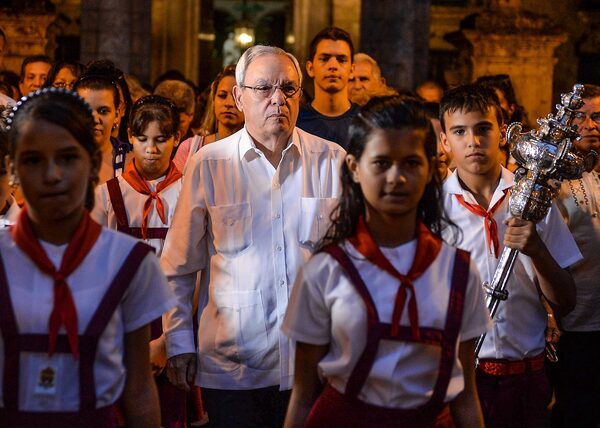
Cuban children accompanied by historian Eusebio Leal Spengler bring the ceremonial maces from the town hall to the Templete church during celebrations for the 495 anniversary of the foundation of Havana on November 15, 2014.YAMIL LAGE/AFP/Getty Images
Eusebio Leal Spengler, who led an effort to preserve Old Havana, transforming that historic district from a forgotten slum into an architectural jewel and tourist destination, died July 31 in Havana. He was 77.
His death was reported by Granma, the official newspaper of the Cuban Communist Party. In recent years, he had been treated for pancreatic cancer.
In a statement, President Miguel Diaz-Canel of Cuba called him “the Cuban who saved Havana.”
Mr. Leal began his preservation efforts in the 1980s, when the old centre of the capital city was a ruin. Residents lived without indoor plumbing or reliable electricity, garbage piled up on the streets and 250-year-old buildings sometimes collapsed before their eyes.
As a historian and director of the Havana City Museum, Mr. Leal was passionate about saving Cuba’s architectural history. He once lay down in front of a steamroller to save a colonial-era wooden street from being paved over. Through his campaigning, Old Havana was designated a UNESCO World Heritage Site in 1982.
But lack of funds hampered Mr. Leal’s ambitious restoration plans until the early 1990s, when the Soviet Union collapsed and Cuba lost millions in subsidies. Out of the economic crisis, Cuban leader Fidel Castro, whom Mr. Leal had befriended, gave him unprecedented authority to collect taxes and profits from tourism in the old centre.
Through a state-run company, Habaguanex, Mr. Leal plowed money into construction projects. He restored elegant 18th-century plazas, baroque cathedrals and restaurants and hotels, including the pink-washed Hotel Ambos Mundos, where Ernest Hemingway wrote For Whom the Bell Tolls. Paradoxically, Old Havana became a capitalist success story: The restored buildings drew foreign tourists, whose money then paid for more restoration work.
By the mid-2000s, about 300 buildings – roughly a third of those in Old Havana – had been refurbished. And Mr. Leal, who employed 3,000 workers as head of the Office of Historian, was hailed as a hero and a role model for preservationists around the world.
“He was a unique figure for his time,” said Jeffrey DeLaurentis, a U.S. diplomat who served in Cuba during the Obama administration. “He was also given an unusual amount of autonomy. It was very novel in the system that Cuba has.”
As Old Havana became an economic engine for Cuba, Mr. Leal was known as its unofficial mayor. He greeted well-wishers on the streets (typically in his bureaucratic gray guayabera shirt). He starred in a TV series about the capital’s history, Andar La Habana (Walk Havana). He lectured at American universities and was sought out by journalists as a leading public intellectual.
Old Havana’s renewal came at a cost, however; some residents were relocated when overcrowded buildings were modernized. Preservation had its limits, too. Visiting journalists, including one from The New York Times in 2007, pointed out that Old Havana had become like a movie set, a pretty façade, while just blocks away poor Cubans lived in decrepit buildings. Workers at fancy hotels scraped by on a state salary of US$20 a month.
As Mr. Leal himself told the Times, revitalizing Cuba’s colonial architecture had done only so much to fix larger social ills.
“It pains me to see every day the border that divides what has been restored and what remains to be restored,” he said.
Eusebio Leal Spengler was born on Sept. 11, 1942, in a working-class district of Havana. He was reared by his single mother, a washerwoman and cleaner, and dropped out of school in the sixth grade to help support the family. No other information was available about his mother or father. Survivors include his two sons, Javier Leal and Carlos Manuel Leal.
After the 1959 revolution brought Castro to power, public education in Cuba became free. In 1975, Mr. Leal earned a bachelor’s degree in history, and later a doctorate in historical sciences, from the University of Havana. But he had early on been self-taught, spending his youth in libraries reading about history and architecture. In the early 1960s he was made an apprentice in the Office of Historian, held at the time by Emilio Roig de Leuchsenring.
When Mr. Roig died in 1967, Mr. Leal assumed the role and oversaw the renovation of the 18th-century governor’s palace into a museum, his first restoration project.
“By ancient tradition, every old city in Latin America maintains the institution of ‘chronicler,’ who is named for life to save the memory of the city,” he told Smithsonian magazine in a 2018 profile.
But Mr. Leal did not want Old Havana to be a mummified city for tourists. He used a portion of the Habaguanex profits to build schools and health clinics and to repair apartment buildings so that long-time residents could remain. As he told The Washington Post in 2000, he took care to create “spaces of silence” in his plan — living neighborhoods removed from the tourist hordes.
His success brought him political influence. As a practising Roman Catholic, he sought to improve the relationship between the Catholic Church and Cuban authorities, who had dispelled priests after the revolution and officially espoused atheism. When Pope Francis visited Cuba in 2015, Mr. Leal showed him around.
Building by building, block by block, he continued his preservation efforts until the end of his life. One of his last and most ambitious projects was the restoration of the National Capitol Building, which, with its domed roof and neoclassical architecture, resembles the U.S. Capitol. It opened in 2018 after eight years of work.
“What we’re doing here is trying to preserve the patrimony, the memory of the Cuban nation,” Mr. Leal told The Times in 2005.
“I won’t see the full restoration of the city,” he added. “So much is left to be done, but this is a start.”